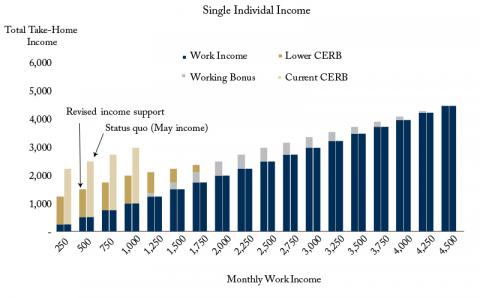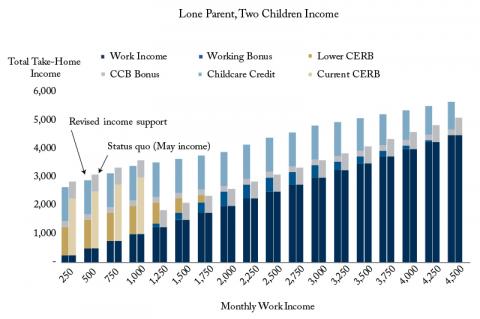From: Alexandre Laurin and Benjamin Dachis
To: Finance Minister Bill Morneau
Date: May 25, 2020
Re: An Income Support Plan to Support the Recovery
The first cohort of Canada Emergency Response Benefit (CERB) recipients are about to lose eligibility on July 5. Ottawa must announce soon what’s next.
As the province-by-province restart begins, income support needs to shift from broad-based programs to targeted initiatives addressing the lingering economic pain. Governments should balance the need for a continuing safety net with encouraging those who can find safe and rewarding work to do so.
The recovery and restart income support plan should have three complementary pillars:
- Extend CERB eligibility for a limited time to those who, after 16 weeks on the CERB, do not become eligible for Employment Insurance (EI). The maximum CERB amount should be scaled back, from $2,000 to $1,000 for example. And rather than have workers lose all of the CERB when they earn more than $1,000, let them keep a declining portion as they earn more. Ottawa and businesses will also need to enforce eligibility and return-to-work requirements. Ottawa will need to invest in income verification administration for EI and CERB.
- Enhance the Child Care Expense Deduction and the Canada Child Benefit (CCB). Women are bearing the brunt of labour income losses. Limited childcare options will impede the recovery for women the most. A big, temporary boost to the CCB cash transfer and a revised childcare tax credit providing enhanced support to low-income earners is the best way to target families with dependent children. A richer CCB supports families whether or not they find childcare. A childcare expense credit will expand childcare options – subsidizing a wide range of in-home childcare options, incenting a larger supply – for those who can get back to the workforce. A targeted program lets parents choose for their family.
- A new temporary “Working Bonus” modeled on the Canada Workers Benefit (CWB). The CWB is a refundable tax credit that tops up employment income for low-income earners and increases as workers earn more. A new monthly Working Bonus should be the core of the job-recovery and stimulus plan. The bonus would go to everyone earning a monthly income above a certain threshold, growing with income until it is phased out. It would be especially useful to those who worked in sectors that are not recovering and who need to find jobs elsewhere. It could dovetail with the proposed scaled back CERB, clawed back one-for-one with employment income. It could be administered alongside the current monthly income test for the CERB, or alternatively alongside the CWB, in which case workers could get a 50 percent immediate subsidy for their income, with the rest to come at tax filing next year. Provinces could also modify the phase-in or -out, as they do with the current CWB, or potentially top-up this bonus.
These three pillars would work together. Reducing the CERB only works for families if they have certainty that they will be able to afford childcare or otherwise support their families’ basic needs. Such a wind-down of CERB leaves the most vulnerable (a low-income single parent currently receiving the CERB with two children, for example) in a similar situation, and better off if they earn more than $1,000 of income and use childcare. Those without family obligations facing lower CERB payments would benefit from the Working Bonus and the reduced and income-tested CERB, encouraging the restart.
The fiscal outlook for this year and beyond would likely dictate the exact dollar figures for the above proposal. The enhancement to the CCB and the Working Bonus could be partly paid for out of announced programs by scaling back the CERB and a wind-down of the Canada Emergency Wage Subsidy, lowering the net cost of the economic stimulus. Such a recovery and stimulus plan centered around the needs of low-income workers and women should be Ottawa’s focus.
Notes:
- CERB scaled back to a monthly maximum of $1,000 phased out with income over $1,000;
- Working Bonus phased in at a rate of 50 cents per dollar of earnings over $1,000 and phased out at a rate of 25 cents per dollar of earnings over $2,500;
- CCB bonus of $100 per month per child; status quo CCB bonus of $300 per child for May
- Refundable childcare credit of $600 per child phased out on a sliding scale of family income.
Alexandre Laurin is Director of Research at the C.D. Howe Institute and Benjamin Dachis is its Director of Public Affairs.
To send a comment or leave feedback, email us at blog@cdhowe.org.
The views expressed here are those of the authors. The C.D. Howe Institute does not take corporate positions on policy matters.







